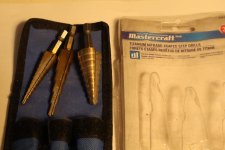ModuShop: www.modushop.bizWhere did you get the volume knob you showed in the video on deburring above? Movishop? Novishop?
Tom
To get a nice clean hole, I drill to about 3/4 of the thickness and then the last bit from the other side.
Is it possible to get a 4 mm. single flute drill for the actual hole drilling ? I understand that it should put less stress/heat in the actual drilling ?I found the single flute type a better choice for me. Works smoothly in a hand held drill or drill press.
Single Flute Countersink
Thanks. What deburring countersink bit SIZE would you recommend for a 4 mm. hole ?If you're gonna drill: start with a 3mm (1/8") bit. Use cutting oil, 3-in-1, something. After making the first hole with a twist bit, get a Step Bit to make the larger holes. A twist bit will bend thin sheet metal as it goes in, don't use big twist bits on thin sheet metal. There are many deburring tools out there, for sheet metal I like to use a Countersink Bit, but not one with flutes, they chatter. Use one with a hole through it, like this:
View attachment 1317143
This will give you the smoothest edge.
Try to practice a couple cuts on similar material, if possible. Go slow. Have fun!
w
That many holes?
Sorry but not doable by hand, even with a bench drill, because 4mm twist drill is too thin and flexes, so you will lose alignment
Proper solution is punching them.
Plan B is to cut a window the size of the whole ventilation area, say 5 by 10 cm or whatever you need, it will be easier to get clean edges or worst case file them down, and cut a proper sized rectangle out of commercial perforated sheet (which is punched) and resistance spot solder or worst case Epoxy it in place.
Spray painting everything in semi-gloss black paint will disguise any small imperfections.
We are talking home accessible solutions here, the chassis you show was CNC punched before final bending and painting.
.
.
Sorry but not doable by hand, even with a bench drill, because 4mm twist drill is too thin and flexes, so you will lose alignment
Proper solution is punching them.
Plan B is to cut a window the size of the whole ventilation area, say 5 by 10 cm or whatever you need, it will be easier to get clean edges or worst case file them down, and cut a proper sized rectangle out of commercial perforated sheet (which is punched) and resistance spot solder or worst case Epoxy it in place.
Spray painting everything in semi-gloss black paint will disguise any small imperfections.
We are talking home accessible solutions here, the chassis you show was CNC punched before final bending and painting.
.
.
I call these inlays. Another reason to just DIY the whole case in the first place with a basic desktop CNCPlan B is to cut a window the size of the whole ventilation area, say 5 by 10 cm or whatever you need, it will be easier to get clean edges or worst case file them down, and cut a proper sized rectangle out of commercial perforated sheet (which is punched) and resistance spot solder or worst case Epoxy it in place.
@OSLO I will share the links, but I don't know if you can purchase them from overseas. but you know what they look like now 😉
19mm countersink with Hex shaft from Amazon - use with your angler and drill/impact. carefully.
KEO 53511 Cobalt Steel Single-End Countersink, Uncoated (Bright) Finish, 82 Degree Point Angle, Round Shank, 1/4" Shank Diameter, 3/8" Body Diameter this type stays seated and centered in the hole much better than the fluted types. cleaner results.
19mm countersink with Hex shaft from Amazon - use with your angler and drill/impact. carefully.
KEO 53511 Cobalt Steel Single-End Countersink, Uncoated (Bright) Finish, 82 Degree Point Angle, Round Shank, 1/4" Shank Diameter, 3/8" Body Diameter this type stays seated and centered in the hole much better than the fluted types. cleaner results.
Could I use this HSS single flute milling bit for drilling 4 mm. holes in the 1 mm. steel plate (using a Shapeoko CNC) ?
https://cnc-plus.de/en/end-mills-di...e-milling-bit-end-mill-4-00-mm-15-coated.html
https://cnc-plus.de/en/end-mills-di...e-milling-bit-end-mill-4-00-mm-15-coated.html
Attachments
I'm going to say no, but I've never even seen one of those before. Looking at the length, there's a good chance it will just break.Could I use this HSS single flute milling bit for drilling 4 mm. holes in the 1 mm. steel plate (using a Shapeoko CNC) ?
If you're using a CNC, then just use proper drills or slot mills.
jeff
Sure. If you have flat sheet and a vacuum chuck... 🙂 If all you have is hand tools you'll probably lose a finger.Could I use this HSS single flute milling bit for drilling 4 mm.
Tom
Pretty good plan in my view. You can also attach it with screws. It can be made to look nice.Plan B is to cut a window the size of the whole ventilation area, say 5 by 10 cm or whatever you need, it will be easier to get clean edges or worst case file them down, and cut a proper sized rectangle out of commercial perforated sheet (which is punched) and resistance spot solder or worst case Epoxy it in place.
Tom
- Home
- Design & Build
- Construction Tips
- How to drill 4 mm holes in 1 mm. Steel and avoid grates?

